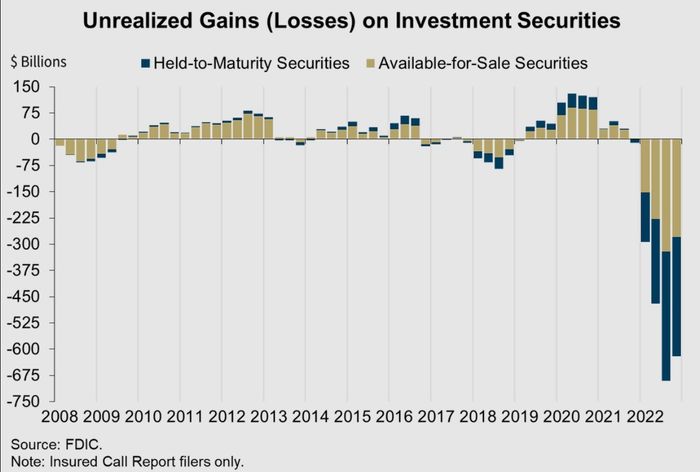Silicon Valley Bank’s collapse a week ago Friday has exposed a big problem with “safe” securities bought with government guarantees during the pandemic.
In the wake of SVB’s implosion, the Federal Reserve wants to contain potential risks at other banks holding similar securities by helping them avoid forced asset sales, which could further undermine confidence in the banking system.
Worries about European banking giant Credit Suisse, CS, -6.94% which has lost money for five quarters in a row, also intensified after Bloomberg reported that that its top shareholder said it couldn’t invest more in the bank above its 10% threshold. Turmoil related to banks have weighed on the stock market and on bonds.
Here’s an explainer on what went wrong with Silicon Valley Bank’s investment securities, and why it matters to calming markets and the Fed’s inflation fight.
SVB Financial SIVB, -60.41% a week ago disclosed a sudden sale of about $21 billion of high-quality, rate-sensitive mortgage and Treasury securities at a $1.8 billion loss, which caused customers to flee with their deposits and ultimately led to the bank’s failure on Friday.
SVB Financial Group said Friday it has filed for Chapter 11 bankruptcy in New York and will seek a court-supervised reorganization.
SVB Financial Group filed for Chapter 11 bankruptcy in New York on Friday, affecting the holding company but not Silicon Valley Bank, which is no longer affiliated with SVB, after it was placed in receivership last week following a run on its deposits.
The Fed’s focus, with the help of a new emergency bank funding program rolled out over the weekend, has been heading off any contagion at other U.S. banks heaped with paper losses from similar low-coupon pandemic-era securities. Its efforts intend to help steady markets, even if it isn’t a perfect cure.
U.S. banks borrowed almost $165 billion from the Fed in the past week after the failure of Silicon Valley Bank, according to data released Thursday.
“It doesn’t change the interest-rate risks,” said Scott Buchta, head of fixed-income strategy at Brean Capital, of bank access to the Fed program. “But the idea is that banks can have access to liquidity without becoming forced sellers, so you have fewer banks that get taken over.”
Buchta, a veteran of the Bear Stearns’ mortgage division before its collapse, said that instead of the Fed sopping up a toxic subprime mortgage mess like the one that toppled banks in 2008, central bankers in the past few days have been “putting out a fire they helped create.”
The new Fed facility provides up to $25 billion in credit protection to banks that use it, which is set to run through at least March 11, 2024.
‘These are not toxic’
After the Fed kept credit flowing and cheap for the most part of the past two decades, last year it began to raise interest rates aggressively to fight inflation that reached its highest level in 40-years.
Higher rates, however, eroded the value of most bonds, including those with low-coupons considered “safe” because of their government guarantees that protect investors from credit losses if a borrower defaults.
Because interest-rate and liquidity risks aren’t covered by those guarantees, a deluge of low-coupon bonds created in 2020 and 2021, like the ones Silicon Valley Bank was buying as its pandemic deposits rose, have been acutely vulnerable to the Fed’s quickest pace of rate hikes in decades.
This chart shows the downward spiral of the value of investment securities held at U.S. banks since the Fed started lifting rates from near zero last March, with an estimated $620 billions in unrealized losses piling up at the end of 2022.

Banks binged on high-quality, but rate-sensitive mortgage bonds and Treasury debt at ultralow rates during the pandemic to offset growing deposits.
FDIC, Whalen Global Advisors
“They are not toxic,” said Kris Mitchener, and economics professor at Santa Clara University, and an expert on the history of financial crises.
Treasurys and government-backed mortgage bonds also were what the Fed had been purchasing since it rolled out a bazooka of pandemic support in 2020, growing its balance sheet to a near $9 trillion peak.
Since last year, however, the Fed has been vocal about its focus on taming inflation, including by dramatically shrinking the size of its balance sheet of Treasurys and mortgage bonds by letting assets it holds mature.
A lingering question after the collapse of Silicon Valley Bank is why it and other midsize banks had not safeguarded their portfolios against the Fed’s reversal of its easy-money stance, Mitchener said.
“That’s the puzzle,” he said. “Because bank management should be concerned about interest-rate exposure and duration risks. That’s something I teach my undergraduates.”
Investors buying new 10-year Treasury notes TMUBMUSD10Y, 3.343% could get a yield of about 2.1% a year ago, whereas the rate was above 4% a week before and closer to 3.4% on Friday, according to Dow Jones Market Data.
“When yields rise, of course, it gets more difficult to get out of those positions,” said Robin Marshall, director of fixed-income and multiasset research at FTSE Russell.
While assets held at big banks have been heavily scrutinized by regulators since the subprime days that fueled the global financial crisis, Marshall said risks at some regional banks seem to have “slipped under the radar.”
Treasurys and guaranteed mortgage bonds, long considered liquid assets because of their backstops, have been types of securities regulators encouraged major banks to own as a buffer from potential losses in the post-2008 era.
Buchta said the new Fed facility, plus the Federal Home Loan Bank raising more than $88 billion in short-term funding to deploy to banks if needed, could help calm investors in the mortgage bond market.
The iShares MBS ETF, MBB, +0.96% which tracks an index of government-backed mortgage securities, was up 1.3% on Friday, while the S&P 500 index SPX, -1.10% shed 1.2% and the Dow Jones Industrial Average DJIA, -1.19% fell 1.3%.
Should market jitters around banks calm down, Buchta said the hope is the Fed can focus back on fighting inflation.
“They’ve got to keep that up,” he said.





